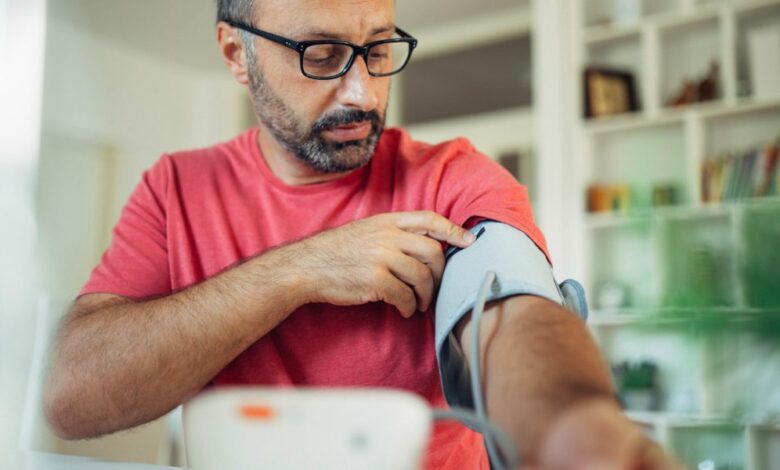How to control high blood pressure without medication


More than half of all American adults have high blood pressure, according to the American Heart Association (AHA), and many don’t even realize it. There are often no symptoms, and when left untreated, the damage can be a significant contributing factor to heart attacks, strokes, and other health threats. If your last doctor’s visit revealed that have high blood pressure, the good news is that bringing it down is often well within your control.
Lifestyle changes, mostly exercise and improved diet, are key. The best news is that when you take a dedicated approach, you can bring your high blood pressure down into a normal, healthy range in a relatively short period of time—as quickly as four to six weeks in some cases. Before you pick your approach, however, you need to understand your numbers, the risk they present, and whether medications are necessary, at least in the short term.
What is high blood pressure?
- The AHA defines a normal blood pressure reading as less than 120 over 80.
- Elevated blood pressure is 120-129 and less than 80
- Stage one high blood pressure is 130-139 or 80-89
- Stage two is 140 or higher or 90 or higher.
- Anything higher than 180 or 120 ranks as a hypertensive crisis that you must address immediately.
So, when must you use medications and when can you safely lower your blood pressure with lifestyle? “I don’t use a hard number, but until you reach stage one or two, I probably wouldn’t initiate medications,” explained cardiologist Matthew Martinez, direct of Atlantic Health System’s Sports Cardiology at Morristown Medical Center in New Jersey. “Above that, however, and you’ll probably need to start with medication while changing your lifestyle. As you go along, you can reduce or cease medication if your body is responding.”
If you fall into the elevated category, then, with a consistent change in diet and exercise, you can likely bring down your blood pressure without needing medications. Here’s how.
Diet to lower high blood pressure
High blood pressure responds well to a healthy diet, according to Michelle Routhenstein, a registered dietician specializing in cardiology, and owner of Entirely Nourished. “There is a subgroup of patients who have resistant hypertension, but for most people, good nutrition can lead to significant reductions in a short period of time,” she said. “Lowering sodium intake is usually the first step, but it’s also important to add certain foods to your diet.”
Sodium intake is a particularly harmful issue in the typical American diet, according to cardiologist Tariq Hafiz, medical director at Pritkin Longevity Center in Miami. According to the AHA, the average person consumes around 3,500 milligrams of sodium every day, when they should top out at 2,300. “Most of the foods we eat contain excess sodium,” said Hafiz.
Getting away from processed foods is one of the quickest fixes for excessive sodium intake, as is setting down the salt shaker during cooking or eating. “If you shop the outside of the grocery story, you’ll find the healthy fruits and vegetables,” says Martinez. “The middle is where the processed foods are and should be avoided.”
While reducing sodium, you should also add in foods that naturally contain magnesium, potassium, and calcium, says Routhenstein. “Vegetables like beets and green leafy vegetables are good sources,” she explains. “Also add in nuts, seeds, legumes, fish, and lean protein. Work with a registered dietician to ensure you’re getting adequate volumes, however, for your age, gender, and activity levels.”
You can also explore the DASH Diet (Dietary Approaches to Stop Hypertension) and a Mediterranean diet approach. Diet is one big component of blood pressure reduction, but so too is exercise.
Exercise to lower high blood pressure
To achieve the best results with lifestyle changes aimed at reducing blood pressure, you should couple a healthy diet with exercise. The AHA recommends the equivalent of at least 150 minutes per week of moderate-intensity activity, such as brisk walking, swimming, or riding a bike. Alternatively, you can aim for 75 minutes of vigorous activity, such as running, or aim to do a combination of both. “You don’t have to do it all in one session,” says Martinez. “Aim for 30 to 40 minutes a day of aerobic activity, three or four days a week.”
You can also add in strength training to make your muscles stronger and more efficient, as well as lower intensity exercises like yoga, which can also help reduce stress. “Within four to six weeks of regular exercise, you can reduce your blood pressure by five to 10 milliliters,” says Hafiz.
Don’t neglect sleep, either, which allows your body to recover and rest, ultimately helping your blood pressure, too. If you’re a smoker, that’s an immediate habit to drop, says Martinez: “There’s no ambiguity there.”
With consistency, and the intent to make permanent lifestyle choices, you can hopefully lower your blood pressure once and for all. “You shouldn’t treat this as a passing fad,” says Hafiz. “Make it maintenance therapy.”
Source link




